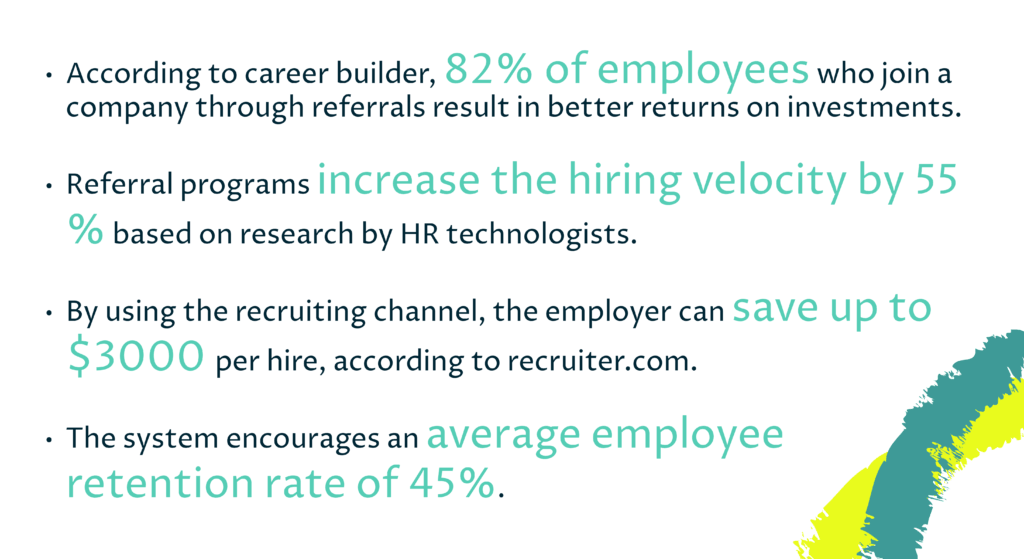Why use Referrals
Employee referrals are an effective strategy that helps companies attract quality talent from professional networks. Anyone in the company can refer a colleague by sharing their resume with the hiring manager.
When an existing employee refers a candidate, they know that the individual meets the minimum requirements for the job and fit the company. Therefore, the talent acquisition team can quickly fill the position without dedicating much effort and time to job postings and candidate screenings. With this method, companies save a substantial amount of advertisement money.
Additionally, employee referrals can reduce employee retention rates in two ways. Most referred candidates already have an idea of what it’s like to work for the company from hearing stories from their referer. They, therefore, actively choose to be part of the company culture and will stay with the company longer. Simultaneously, hiring a referral means that the referer is actively shaping the company, meaning they are motivated to stay with the company longer.
Moreover, this hiring channel works best when searching for the right candidate for hard-to-fill roles. Some positions require a thoughtful selection, for instance, when rare skills are needed in a very competitive space. Employees can help identify potential candidates from their network and persuade them to join the company with a referral.
Advantages of Referrals for the Company
The success of an employee referral program depends on its implementation. A clear communication of the program throughout the organization, feedback on referrals for employees, and recognition of referers’ efforts are some of the key factors that determine the program’s success. Read our essential recruitment guide for employee referrals for a full list of things to consider when implementing a referral program.
If implemented correctly, companies can expect these benefits from an employee referral program:
It Strengthens the Employer Brand
When employees continuously share job openings of a company, it helps to increase the organization’s social reach. This, in turn, attracts more potential candidates, who can be turned into applicants. Additionally, referrals are an authentic way of employer branding. Who would promote a position in a company they don’t like working at? By sharing open jobs, employees, therefore, become the company’s brand ambassadors, encouraging other people to work for the organization.
It Helps to Find a Cultural Fit
Allowing employees to actively shape the company will increase the cultural fit of candidates. Employees will start to look for candidates that fit into the company culture, meaning a similar work mentality and character. Moreover, referrals reflect on the referer to some extent. Therefore, employees will not refer candidates not suited for the position.
The Company Gets Like-minded Employees
A referral application by known referrals instills confidence in a company that they will get reputable and valid employees. There is a close correlation between your top-performing employees and their refereed candidates. Most likely, a higher performer attracts other high performing individuals into the team.
It Helps Reach Out To More People
As mentioned above, when employees continuously share vacancies on social media it increases the company’s social reach. Therefore, organizations reach more people, including passive candidates, who are potential applicants. The more candidates you have, the higher the chances of selecting the best fit.
It Boosts Returns on Investment
The recruitment process is quite expensive, with various indirect and direct costs involved. A referral bonus, however, is only a fraction of what an organization would pay for a recruitment agency. Since the referral schemes attract more relevant profiles, they reduce hiring costs, which results in a higher ROI.
It Results In a Higher Level Of Employee Satisfaction
When employees understand that their work is valued and that they can actively shape the company, they are more satisfied with their work. As a result, productivity increases. Employee referrals help to establish a trusting work environment, which boosts engagement levels and general happiness.
Why Referrals are the Best Recruiting Channel
Great talents serve as a foundation for each organization. Companies thrive when they manage to attract employees who understand the firm’s goals and work hard towards achieving them.
When choosing a successful recruiting channel, talent acquisition teams look at various metrics. Cost per hire, quality of hire, and employee turnover are some examples. So how do employee referrals compare to other channels?

How to Motivate Employees to Refer Candidates
When introducing employees to a new referral program, some aspects are important to consider to ensure the program’s success in the long run.
Educating Employees
Especially at the very beginning of launching a referral program, employees should understand how the program works and why it was implemented. Showing some relevant data and statistics connected to hiring can help employees understand what impact their referrals can have on the company. This will motivate them to sign up for the program.
Incentivizing the Referral Program
Include a mix of monetary and non-monetary rewards to lure your employees into the program. Some creative rewards that organizations can incorporate include paid vacations, prizes, or dinner at a fancy restaurant. However, while rewards for successful referrals are self-evident, all other employees who participated in the search for a candidate should be rewarded for their efforts as well.
Simplifying the Process
With rising stress levels in every job in the modern world, employees might view the referring of candidates as an additional burden. Therefore, to participate, they need an intuitive and straightforward referral process. Providing a direct and easy way to submit referrals can increase participation. Moreover, integrating advanced tools into the program to centralize and keep all the activities organized can encourage employees to refer candidates and reduces administrative work for the talent acquisition team.
Keeping Employees Interested
After an initial surge in the referral program, employees might lose interest or forget about referrals altogether. To avoid this, the talent acquisition team can work together with marketing to create internal marketing strategies for the program. Progress updates, internal competitions, and gamification can help to keep employees engaged in the program.
Building a Foundation of Trust
Transparency is a key factor in employee referral programs. If employees never hear back about their referral, why would they bother to keep referring candidates? A transparent process where the talent acquisition team gives feedback on every referral and keeps employees updated on the status of their referrals can help to keep employees engaged.
Conclusion
Recruiting top-performing talent that fits the company has become very challenging in the current job market. With a referral program, organizations can reach out directly to those candidates they are looking for, making employee referrals a cost-effective and quick way to fill open positions. To ensure the long-term success of such a program, however, companies have to keep their employees engaged in the program.
Do you want to know how your company can benefit from Firstbird’s digital employee referral program?
























